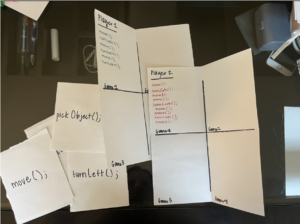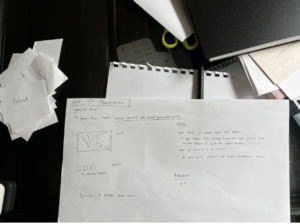Game of Queens A History of Influential Women
Inspiration
Over the course of developing my educational game, I started and half-completed a few games teaching various subject matter. I started off with trying to teach computer programming, creating a simulated game mimicking the Karel curriculum of 106a. I quickly realized that the game simply wasn’t that fun and didn’t translate well to a paper medium (Appendix 1). Then, I moved on to wanting to teach geography, acknowledging that it’s not a college-level topic per say but a topic that many people forget when they come to college. I realized that a location-based game would be difficult without some sort of mechanism of drawing or throwing to mark locations. I then slightly shifted gears to wanting to create a card game like B.S. where people could assert their knowledge, or lack thereof, on country capital cities (Appendix 2). I was going to continue to pursue this avenue, until I accidentally discovered a card game in my friend’s room that inspired me to create a game that would teach you a little bit about historical and influential women. The documentation for my failed games is located at the bottom of this blog post.
My game was inspired and heavily influenced by the game I discovered called Game of Queens: A Drag Queen Card Race. The game is merchandise for the television series Ru Paul’s Drag Race. The card game is an altered version of the traditional card game Top Trumps. In Game of Queens, there are two main pieces: the first is a booklet containing the rules of the game and small blurbs about the drag queens and the second is a deck of cards with photos of the drag queens in question and statistics about them. The gameplay is simple, the deck is evenly distributed and players take turns stealing cards according to who has the better statistics. I thought that even though the game was slightly dry (it’s mostly luck based), it was a really great educational opportunity to learn about the drag queens and important elements of drag racing. (Eureka!)
Concept
I decided to take this game and give it a twist to teach about historical and influential women. The game is ideal for two players, but can be played by more with slight modifications. The game will be primarily competitive without much challenge or collaboration involved. There is a slight bit of memory involved as it’s a small deck and order matters with respect to calling out statistics. The ideal learning outcome is that players will be able to recall a higher number of influential women after playing the game than before. I measured it by having game testers list as many historical and influential women as possible before and then again after the game to see whether the game expanded their knowledge base. I wanted to do this sort of game because since coming to university there are a number of simpler disciplines that I’ve lost knowledge of due to not being exposed to them as frequently as I was in high school. History is one of those such subjects. I think this game will refresh memories and educate players on important historical figures with a feminist approach. As mentioned above, games similar to this are Top Trumps and Game of Queens: A Drag Queen Card Race. My biggest concerns were that the game would be over too quickly or not be very fun, but I hoped that it being actually educational would make up for that.
Rules
The rules of the game are simple and the same as the traditional card game Top Trumps, but are pasted below directly from my game’s design (for two players).
- Shuffle all cards
- Distribute full deck to both players, evenly split
- Flip a coin to determine which player starts
- Player 1 choses and calls out their best statistic (E.g. Legend Factor 99)
- Player 2 tries to beat that statistic, the best statistic wins
- The card with the highest statistic wins the round and the player wins the top card from their opponent and adds it to the base of their pile
- The winner of the round goes first the next round
- The first player to have all of the cards wins!
Printable PDF
The only other parts of the game are the deck of cards and the booklet with descriptions of the women on the cards and the game rules. The nice thing about this setup, that is with so few game parts, is that it can be expanded upon later on very easily with little to no disturbance to game play. You can make the game yourself by printing this PDF.
Assessment
In terms of assessment, it’s somewhat difficult to truly assess learning after just one or more rounds of the game. I also wanted the assessment to not be particularly burdensome to my gameplay volunteers (friends) so I added a time constraint. Recall that the main learning objective of this game is to increase the players’ knowledge of influential women, past and present. As such, I wanted to assess the strength of their knowledge when it came to influential women, focused on quantity over quality at this point as the game doesn’t support learning details so much as familiarizing players with names to hopefully spark interest outside of the game. Keeping these factors in mind, my pre-assessment was a 1-minute time constrained opportunity for my players to list off as many influential women as possible, past and present. I then conducted the same assessment after 1 round of playing the game to see whether players’ scores would increase, or if at the very least some of the women on the game cars were included.
For four of my volunteers, this is how their numbers changed before and after the game.
Player 1:
Before, 18 – After, 24
Player 2:
Before, 12 – After, 21
Player 3:
Before, 20 – After, 30
Player 4:
Before, 14 – After, 23
All of the players were able to recall more women after playing the game than before, which makes sense given they just played a game wherein they were exposed to about thirty additional influential women’s names. I would be interested to see how this would change after any amount of time passes since game play, hours, days, weeks. But, for the purposes of this assignment I thought it was really cool that my metric of success was actually successful!
Learnings/In the Future
I think that the game was a decent success, even if it isn’t the most attention-grabbing and exciting. It achieved the learning objective of increasing players’ awareness of influential women. Crazy when you think about how many men we can name and how few women. In the future, I’d like to make a version of the game where players’ could actually learn facts about the women in question without reading through a booklet. The game could also be easily expanded to add more cards of influential women. I think that the big thing this project taught me is the difference between a game that teaches and a game that teaches that still maintains the quality of a game.
Final Playtest Video
Here is a video of my friends doing a final playtest https://youtu.be/dX2019u-fO4
Appendix 1: Maze Karel
Very briefly, the idea behind this game was to teach people how to code with Karel. Instead of having Karel maneuver through the levels we did in 106a, I wanted to make it a bit more fun and challenging by having players maneuver Karel through a maze. So, to play-test this bit initially I made card with Karel’s commands,
move()
turnLeft()
turnRight()
pickObject()
I then had players pull up an online maze game and write out the commands they used to maneuver Karel through the maze. I did this twice, and I found that it was just immensely boring so I shifted gears to my second idea.

Appendix 2: Geography game
For this game, I wanted to refresh people’s knowledge of countries. So I thought at first that I could have a game where people would draw on a map the location of a country that they draw from a deck of cards with all country names. I thought that would be hard to make as it would require a lot of maps, printing, and drawing.
So, later I thought of something else where it would be a game in the style of the card game B.S. with a deck of cards with all country names. Players would pull a card and if they knew the country’s capital they would be able to take it out of their hand, and in the process of placing it down others could call B.S.
I never play-tested this but I did run the idea past a few of my friends and nobody seems particularly interested in it as a mechanism for re-learning geography.

WC: 1450



Check out https://erinkmalone.medium.com/recognizing-interaction-design-work-172ad8eea3e8